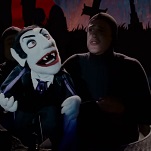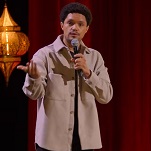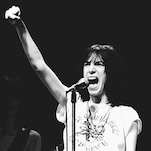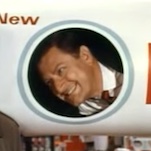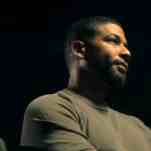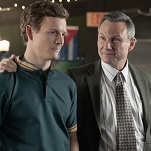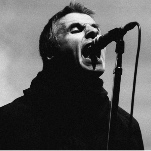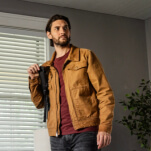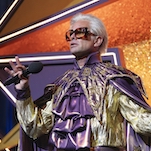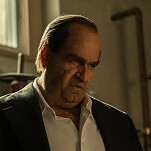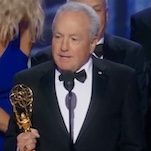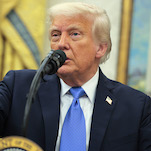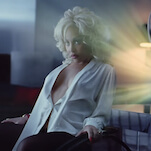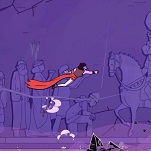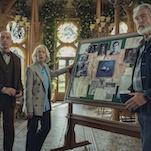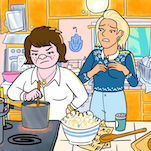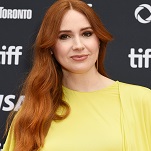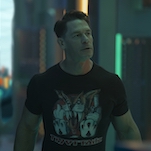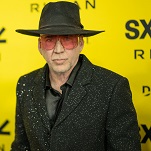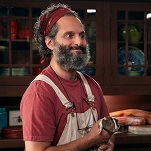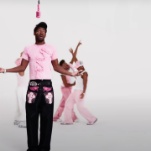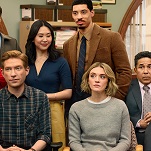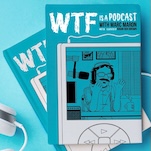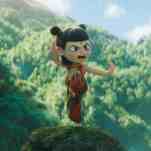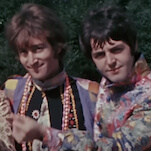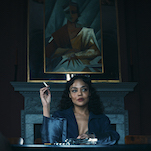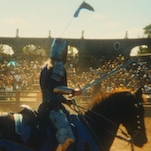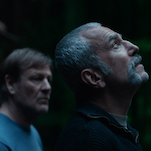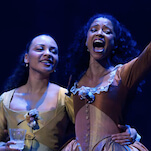John Mulaney’s weird, often surreal stand-up comedy had already won him admirers before he joined the writing staff of Saturday Night Live in 2009, but his work on the sketch show—which included co-creating the character of Stefon with Bill Hader—broke him through into the sort of name comedy nerds knew well and followed the career feverishly. Since he left SNL, he’s appeared frequently on a variety of programs—most notably as George St. Geegland on Kroll Show—but he’s largely been working on Fox’s new sitcom Mulaney, originally developed for NBC but airing this fall on Fox’s Sunday night lineup at 9:30 p.m. Eastern. Mulaney bucks a recent trend in which sitcoms are filmed like mini movies, presented in a single-camera style and aimed toward the young urbanites to drive much discussion about comedy. Instead, Mulaney is presented multi-camera style, meaning it’s filmed like a stage play, from multiple, fixed cameras. That made it only too natural to ask Mulaney…
It also had a flow that is really different than all other comedy that’s followed, even other comedies that were happening in the ’80s. It was really funny, but it was funny just knowing the characters and the family. Some of the biggest laughs on that show are when Cliff walks through the screen door and sees something, and we know how he will feel about it. It’s a show—and I even heard this was sort of Bill Cosby’s approach—that if you could cut out a line from a script, and it was funny on its own, he didn’t want it. He wanted everything to be funny, but not like comedy writing.
It also just has truly weird episodes. They have a whole relay race on one where Cliff is settling an old score with that guy “Tail-Wind Turner” and there’s a huge pre-taped track meet. It just did what it wanted. Having worked on a network TV show now, it fascinates me how they went in and were like, “This episode is all going to be at Hillman graduation, and it’ll be played pretty straight.” [Laughs.]
AVC: So you can keep only one Huxtable child, which one are you keeping?
JM: Young Rudy is pretty damn awesome. Really funny. Do you remember when they made the house into the “real world” for Theo [“Theo’s Holiday”], and she was Mrs. Griswold? She’s pretty great.
JM: Second, almost tied for first, is the show—I don’t know if you’ve ever seen it, Jerry Seinfeld and Larry David did it—Seinfeld.
He played a comedian in New York. It’s very good. I highly recommend it. Yeah, loved Seinfeld. [Laughs.] I don’t need to describe Seinfeld.
AVC: Do you remember the first time you saw it or the first time you were aware of it?
JM: I thought it was really cool that I was watching it, because it felt very grown-up. I felt very hip and adult for kind of getting it. In those early seasons, where it’s a little less bright—if you remember in that first season, Kramer is in a robe a lot, and he’s a stranger character—I remember thinking, “Oh, I like that I’m in on this,” and I was pretty young then. Obviously, I stayed with the show and loved it and loved everywhere it went, but I remember that first feeling of, “Yeah, that I get this makes me happy.”
AVC: The Cosby Show was a very free-form show, but Seinfeld was a very structured show. In the best episodes, every story had a point it was going to and they all tied together in the end. Do you have a preference between those two?
JM: Both have their place. I mean, talk about an influence, all that dovetailing! I think about so many shows since then that have emulated that. That’s huge, beyond the sense, everyone talks about. Oh, it was a show about minutiae, and it’s a show about observational comedy, but beyond that, the structure of the show has been the biggest influence on TV, the idea that stories dovetail together, to the point that it’s almost a default for a lot of people. It’s much more structured, but the best thing is that cast in a room together, the comfort they had with each other. There are some loose moments that really appeal to me. Tangential things that may be related to those excellently crafted stories, but they’re also just free moments of comedy. Those are kind of my favorite.
AVC: When Kevin Reilly introduced Mulaney at the Fox upfronts, he referred to Seinfeld, so he already was drawing that comparison. Is that a comparison you want to run toward or away from?
JM: I don’t want to run any direction from it. I think people will compare the show to it. Maybe some will scoff at the idea of playing myself, as a comedian in New York, and I understand how there are comparisons. I didn’t want to not be a comedian just to avoid that comparison, but I absolutely knew that people might roll their eyes at it from the moment I was first writing it. But I didn’t want to be like an auto mechanic or an architect just to avoid that. I’m a huge, huge fan of Jerry Seinfeld. It’s a huge, huge influence. I think I’m a different kind of stand-up from him, and I think that a lot of the comedy on the show is different, but I should be transparent that I love the show, and I do not, at all, think we’ve reached that crown. [Laughs.]
AVC: You open this show with some stand-up as Seinfeld often opened, but yours is deliberately commenting on what’s going to happen in the episode we’re going to watch. What led you to decide to break the fourth wall like that?
JM: There’s been a lot of direct address in the past 10 years in half-hour comedy. There’s a lot of talking to camera and things like that. I had an idea, and I knew I wanted to do stand-up, and I had this notion of almost like the Our Town stage manager being in front of the sets and telling you what you’re going to see tonight. And I don’t use that language exactly. I’m not saying, “Now, on tonight’s show, Jane’s going to walk through that door…” But I liked the idea of having no pretense about it being a TV show. Never breaking the reality of the show when we’re in it but having these moments when I’m talking to the studio audience and to the audience at home, and they’re like these abstracts. They’re not quite taking place in the time and the space of the show, but right in front of it. So that idea of direct address, and obviously, I knew I wanted to do stand-up. Those were going to be the same thing, and then it just became what you saw.
AVC: Why do you think so many stand-ups have had success in the multi-camera format, including Seinfeld?
JM: Whenever someone has success, it’s just luck and timing and a million factors coming together. For me—I can only speak to me—it brings me up to a level I like, having the crowd right there. I’ve done stuff on sets without audiences, but comedy and the rhythm and the heightening of everything is really, to me, almost an engine, to help get the comedy and the pace to where I want it. I think I’d really miss not being in front of an audience. So as to why so many stand-ups have had success, I remember hearing they would only do I Love Lucy if they could be in front of an audience, because Desi Arnaz thought that Lucille Ball just needed that to go as big and as funny as she could. I imagine that’s the case for a lot of performers.
JM: I Love Lucy, not only as a show and as a great live-audience show, but it got me into being a comedian in the first place, in sort of a back channel way, because I saw Ricky Ricardo’s life and I really wanted that life. I really wanted to sit around the house all day and then go do a show at a nightclub at night. I just thought, “This looks like the best life. You go do the show that night. Maybe you do a little rehearsal, but otherwise you’re just at home.” So when I was about 9 or 10, I started taking drum lessons, because I thought I’d be like a band leader. I took a couple conga drum lessons and thought, ah, that’d be fun to have a mamba band like that. Then I remembered that movie The Mambo Kings, and at the end, I think it’s pretty clear that mambo is over. And I thought, “Oh no! Mambo is very done.” And I probably wouldn’t break through to the mambo audience, as a nightclub bandleader. And my interest in comedy came together, and I thought, “Maybe I’ll be a comedian in nightclubs.” But the idea of just show business was implanted in me very early from I Love Lucy which was on WGN Chicago, playing all the time. Even though it came out 35 years before I was born, it was background for a lot of my childhood.
AVC: That’s a show that has a lot of physical comedy. Is that something you’re comfortable with?
JM: As long as it’s funny, yeah. I wouldn’t want to do a bit that’s too sweaty, like I am not, obviously, the most physical comedian, but I like visual, physical comedy. We also have an amazing cast on the show that is far more talented than me at those types of things. So yeah, as long as it’s funny.
AVC: So much of I Love Lucy and so many multi-camera sitcoms, really, come down to big, set pieces, like the candy factory or the Vitameatavegamin drinking. You’re doing a little bit of that here in Mulaney as well. The scenes are much longer in multi-cam. How do you handle that being the source of the humor, as opposed to the faster paced single-camera scenes?
JM: I love these characters a lot, and I have a lot of confidence in the cast. I really think people will take to them, so having the story told with this cast, I’d almost rather live with them a little longer and have more air. I really do appreciate the air. This is not a good selling point: “We have a lot of air!” But the breathing room of a good cast on a stage in front of an audience, I really like that, and I always try to protect it in the editing, because comedy—like everything else—it’s on steroids and Adderall. It moves a lot quicker and faster and cuttier, and I’ve both grown up with the old multi-cams I’m talking about and these new shows that just move at that pace, an almost animated show pace. We do have a lot of pre-tapes to break that stuff up, and I think that we’re aware an audience might be used to a faster pace. But I also do sit there and think there’s a real energy to just these performers. So I don’t think we’re trading too much by having a three-page, four-page scene just sitting in an apartment.
AVC: Sometimes the set pieces almost function like comedic sketches within the episode, featuring characters you’re familiar with. What has working in sketch comedy taught you about writing for a sitcom?
JM: The biggest difference is in how you treat the characters. Any character in a sketch is in service of the joke, and you can say that they’re a sex offender or a space alien or whatever you need. Any joke can sell out a character. For the most part, you don’t have to have too much faith in a sketch character, so that’s very different in a half-hour where you really have to live with these people and don’t just want their humanity to be sold out by a joke. Also, like we were talking about the energy and electricity of shows now, having written sketches, I do think about episodes having a few really sizable, funny chunks that are visual, that are big, that are almost sketch-like. We’ve done those with pre-tapes. We’ve done those with live audience moments. I think having worked on SNL, it’s in me that it’s awesome to have a big visual moment for the audience. I think set pieces and sketches are very close to each other.
JM: Just a hilarious show. Just great jokes. Still has that great ’80s thing of very serious moments. [Laughs.] There’s really dramatic moments where they’ll go out to commercial on Bea Arthur sort of looking from side to side, upset, while strings play. Very funny to me having developed a show where people are very conscious of what you go out to commercial on and act breaks and things like that. To have a dramatic look from Bea Arthur be your act break is almost ballsy, having put together a few episodes of a TV show.
The comedy was hilarious. That cast is excellent. The characters are so well defined that, I mean, there are ridiculously funny scenes of just four women sitting around that table in the kitchen. They had a lot of episodes where they would just eat cake at night, and they’re still really, really funny. Really good show in terms of the balance of cast, too. Estelle Getty was really much more of an ingredient. She had storylines, but she was also just like a real ingredient that you pop to sometimes. A hilarious show, though. I still watch a lot.
AVC: You, too, have assembled a really great group of actors. How are you figuring out, over the course of your first season, how to use each of them in the best way?
JM: Figuring it out through a nice embarrassment of riches, where we’re often very long. Our director Andy Ackerman is constantly telling me, you are nine minutes over. You saw our fourth episode. There were many more scenes between Elliott Gould and Seaton Smith I regrettably had to cut that made me laugh really hard. We’ve been finding our way by writing a lot for every character, and then, unfortunately, having to cut some of it before it becomes a piece of TV people can see. I’ve been very, very lucky with this cast. I really like writing for all of them, and so the learning curve, in terms of writing for them, has been really joyous. In terms of how to balance it, that’s just a question of, sometimes, post, because we give everyone a lot to do.
AVC: You mentioned Estelle Getty being just an ingredient in Golden Girls, and that’s a really good description of her. Are there characters you view that way in Mulaney?
JM: I wouldn’t say quite yet. I did like that everyone was a story engine, as well. Oscar, Elliott Gould’s character, has episodes where he’s pushing Jane to be different. He works with Motif [Seaton Smith] in the episode you saw. Lou, obviously, Martin Short’s character, is a huge story engine. Let’s say someone isn’t as dominant in a storyline. I still want them to be a story engine, simply because everyone is so funny that if they’re central to the telling of the story, it helps to hold together more. There’s no temptation to cut really funny stuff when it helps the story fit together. As of now, no one’s quite the pop-to ingredient. We really like keeping everyone involved in the story. I’ve said the word “story” so many times.
AVC: Are you enjoying the writing process of finding new lines on set when you’re filming?
JM: Yes. I set out being a little writerly and kind of thinking like, I’ve got this the way I want it, and it’s my show now, and I’d like it as written please. We really work hard on the scripts, and I really love the writing. Since we are a live audience show though, it’s fun to throw in stuff almost for the audience. I’ll never get rid of that stand-up instinct where if I think they’re getting bored even for a second I want to throw in something. I have warmed up to that and now really enjoy it. It keeps it looser. I also have relaxed a little, because it’s not the first one anymore.
5. The Phil Silvers Show (Sgt. Bilko)
JM: Everyone should watch it who likes comedy. Anyone who likes comedy these days should watch it. It’s a couple things that influenced me. It’s the simplest premise. It’s just peacetime Army, and these guys are left with nothing to do. There are just bets and weird dances and finding dates and commandeering supplies and just small, petty goals from a really funny group of petty people. The cast is insane looking. It’s got one of the most eclectic ensembles. The writing is really funny and really subversive and ahead of its time. Very similar in spirit to what Larry David did later, in terms of pay-offs. I think people that like Always Sunny would really like it. It has these dirtbags conspiring for petty shit [Laughs.], and yet it’s the most watchable, lovable thing. It’s a great show. It’s really funny. Phil Silvers is so good and such a good point man for this show. Someone scheming is a great drive to any half-hour comedy.
AVC: So many sitcoms are based in people who don’t really have anything to do and have to come up with something to do. What is appealing about that as a format for television?
JM: I guess that the goals set up are doable and on a scale that could be observed and would be carried out in an economical amount of time. A lot of Bilko is like there’s a dance that Friday night, or someone’s coming for an inspection tomorrow, and they have to get something ready for it. I’ve never thought about that. While not all TV is about the mundane, it’s about the immediate. Why is that? Probably because it’s a produceable thing to show.
AVC: You can draw a line from Bilko all the way up to Lou as that petty schemer character, changing and evolving over the years, but always getting in people’s business. Where did the character of Lou come from, and how has Martin Short playing him informed that character?
JM: I really liked the idea of writing for another comedian, which I had done some of for award shows or talk show panels and stuff. I enjoyed it. I always had good experiences doing it, but it is a funny thing where you’re often working in their home. And as a writer, as a hungry comedian, I try to get my joke in, but really, you’re kind of writing for a personality, so it’s often less of a joke and more of a funny moment. That’s kind of the relationship I have with Martin Short professionally in the show. I could write a hundred jokes, and he would decide to wear a funny hat instead and still get a huge laugh because he’s a big star.
I wrote the character originally pretty bombastic and then just won the lottery, Martin Short wanting to do it. He and I talked a lot about the character throughout the whole process, so it wasn’t just blowhard, it wasn’t just Louie on Taxi or Lou Grant. He’s also a show business success. As stupid or as hacky as the character can occasionally be, he’s a big star, and I would never want to follow him. I always think about that. My character would still never want to do comedy after Lou, because he’s beloved and he can get a laugh with less. Having the charming side of him and the fact that my mother would love him, that really helped balance him in terms of this is not just a bombastic asshole. There’s a lot of charm to him.
AVC: And finally, television comedy—at least critically acclaimed stuff—has been so dominated by single-camera sitcoms, pretty much since Seinfeld ended. In making a multi-cam, what have you learned from those shows and what have you tried to stay away from?
JM: The pace of them has not always informed how I’ve written or how Andy Ackerman has shot the show, but in post, we’ll occasionally break up scenes. We’ll be in the apartment with Jane and Motif, and then there’s a scene of Martin Short, and they were written sequentially. We’ll cut back and forth between them, and they’re both live audience moments, but we’re able to pace it up a little, as we were talking about. Just because audiences expect a certain pace. In terms of what I’ve avoided, I don’t know. Look, for me, this may surprise you, since we might be compared to a show like Seinfeld, but being my first thing, I obviously wanted to think about what differentiated it from other shows. So as soon as we were doing a multi-cam, I didn’t think, “Okay, now I have to make sure it doesn’t sound like The Office.” That was the biggest thing. Just by making it multi-cam, that broke it open for me.
